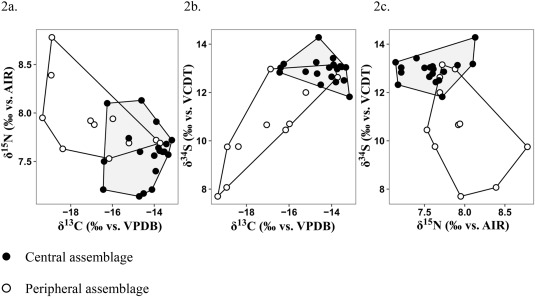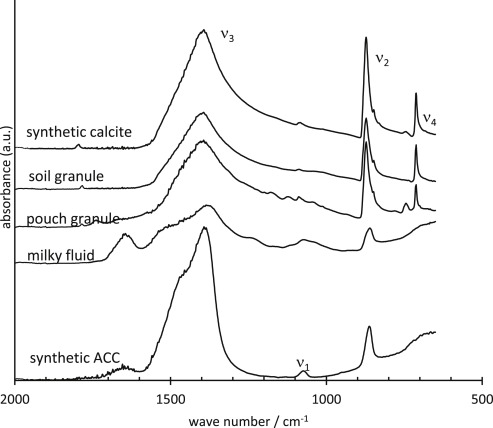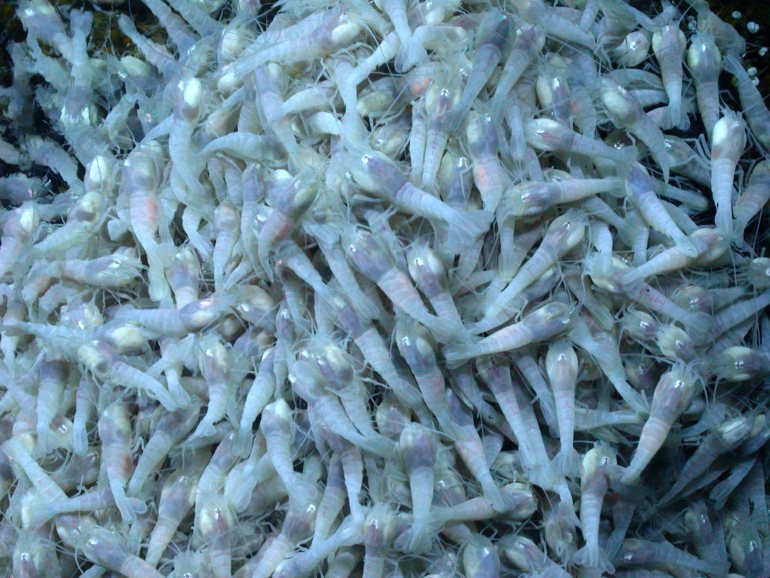Multiple nutritional strategies of hydrothermal vent shrimp (Rimicaris hybisae) assemblages at the Mid-Cayman Rise
A new paper in Deep Sea Research Part I: Oceanographic Research Papers: Multiple nutritional strategies of hydrothermal vent shrimp (Rimicaris hybisae) assemblages at the Mid-Cayman Rise.
• R. hybisae were sampled central to and peripheral of active venting.
• Gut contents differed between central and peripheral assemblages.
• Isotopic compositions differed between assemblages and reflect nourishment source.
• Central assemblages of R. hybisae rely solely on episymbionts.
• Peripheral assemblages have episymbionts and are partially carnivorous.
Alvinocaridid shrimp occurring in dense assemblages close to vigorously venting orifices are characteristic of many vent fields on the Mid-Atlantic Ridge, Central Indian Ridge, and Mid-Cayman Rise. Episymbiotic bacteria of these shrimp are exposed to vent fluids enriched in inorganic nutrients (carbon dioxide, sulfide) that, together with dissolved oxygen in the surrounding seawater, sustain autotrophic growth and supply nourishment to the shrimp. Enigmatically, conspecific shrimp may also be found sparsely distributed in the periphery of a vent field, where there is little visual evidence of vent fluid flux. We tested the null hypothesis that nourishment sources were identical for the central (dense) and peripheral shrimp assemblages, using gut content and stable isotope analyses. Rimicaris hybisae were sampled from central and peripheral assemblages at the Von Damm Vent Field (Mid-Cayman Rise). Guts of centrally aggregated shrimp contained a white material inferred to be bacteria, while peripheral individuals contained this white material and/or pieces of crustacean exoskeletons. C, N, and S isotopic compositions of shrimp muscle tissues were significantly different between central and peripheral shrimp assemblages, and little overlap in isotopic space was found. A comparison of δ13C and δ34S values of gut contents and abdominal tissues revealed that abdominal tissue composition reflects the shrimp’s source of nourishment. Slight but significantly elevated δ15N values in peripheral shrimp, together with crustacean exoskeleton fragments in the gut, suggest facultative carnivory in peripherally aggregated shrimp. The lower δ13C and δ34S values in individuals from the peripheral assemblages are also consistent with a mixotrophic diet. We conclude that central and peripheral assemblages of R. hybisae have different nourishment sources, with central assemblages relying on episymbionts, while peripheral assemblages have diverse nourishment sources comprising bacteria and Crustacea.

Galileo’s Europa – extreme shrimp
The Astronomy Picture of the Day recently linked to my research on extreme shrimp at NASA-JPL. This led to one reader asking whether Rimicaris hybisae might be a lifeform that evolved independently from the rest of life on Earth. Well, we are absolutely certain that isn’t the case. All life as we know it shares a common ancestor, which lived roughly 4 billion years ago. We know this because all life shares certain features at a molecular level, such as the genetic code and homochirality of amino acids and sugars.
In the meantime I went back to writing up the results of the shrimp research (after a break of a few years). So, hopefully more soon!
New research on the development of high-resolution palaeoenvironmental proxies from geochemical properties of biogenic carbonates
A special issue I was a guest editor for, along with Amy Prendergast and Bernd Schöne. Sadly, I did not manage to contribute a manuscript, but still co-authored a very nice editorial.
Carbon isotope fractionation between ACC and calcite
A new paper in Applied Geochemistry: Carbon isotope fractionation between amorphous calcium carbonate and calcite in earthworm-produced calcium carbonate
- Earthworms produce granules of calcium carbonate that form from an amorphous calcium carbonate suspension.
- The microspherulites of amorphous calcium carbonate coalesce and recrystallize.
- Fractionation of C isotopes occurs as the ACC recrystallizes with εcalcite-ACC = −1.20 ± 0.52%.
- This is consistent with a dissolution-reprecipitation pathway rather than solid state rearrangement.
- This may be important for the interpretation of CaCO3-based C isotope environmental proxies.
In this study we investigate carbon isotope fractionation during the crystallization of biogenic calcium carbonate. Several species of earthworm including Lumbricus terrestrissecrete CaCO3. Initially a milky fluid comprising micro-spherules of amorphous CaCO3(ACC) is secreted into pouches of the earthworm calciferous gland. The micro-spherules coalesce and crystalize to form millimetre scale granules, largely comprising calcite. These are secreted into the earthworm intestine and from there into the soil. L. terrestriswere cultured for 28 days in two different soils, moistened with three different mineral waters at 10, 16 and 20 °C. The milky fluid in the calciferous glands, granules in the pouches of the calciferous glands and granules excreted into the soil were collected and analysed by FTIR spectroscopy to determine the form of CaCO3 present and by IRMS to determine δ13C values. The milky fluid was ACC. Granules removed from the pouches and soil were largely calcite; the granules removed from the pouches contained more residual ACC than those recovered from the soil. The δ13C values of milky fluid and pouch granules became significantly more negative with increasing temperature (p ≤ 0.001). For samples from each temperature treatment, δ13C values became significantly (p ≤ 0.001) more negative from the milky fluid to the pouch granules to the soil granules (−13.77, −14.69 and −15.00 respectively at 10 °C; −14.37, −15.07 and −15.18 respectively at 16 °C and −14.89, −15.41 and −15.65 respectively at 20 °C). Fractionation of C isotopes occurred as the ACC recrystallized to form calcite with the fractionation factor εcalcite-ACC = −1.20 ± 0.52‰. This is consistent with the crystallization involving dissolution and reprecipitation rather than a solid state rearrangement. Although C isotopic fractionation has previously been described between different species of dissolved inorganic carbon and various CaCO3 polymorphs, this is the first documented evidence for C isotope fractionation between ACC and the calcite it recrystallizes to. This phenomenon may prove important for the interpretation of CaCO3-based C isotope environmental proxies.

Typical FTIR spectra for milky fluid, a granule recovered from one of the pouches (pouch granule), and a granule recovered from the soil (soil granule); all spectra relate to samples from the same earthworm. Reference spectra for synthetic calcite and ACC are also shown. Spectra are vertically offset on the absorbance axis for clarity. The major calcium carbonate peaks (υ1 to υ4) are labelled. Calcite shows peaks at ∼714 cm−1 (υ4), ∼866 cm−1 (υ2), ∼1090 cm−1 (υ1) and 1420–1470 cm−1 (υ3); amorphous calcium carbonate lacks the ∼714 cm−1 peak.
Biomineralisation by earthworms
A new paper in Geochemical Transactions: Biomineralisation by earthworms – an investigation into the stability and distribution of amorphous calcium carbonate
 Many biominerals form from amorphous calcium carbonate (ACC), but this phase is highly unstable when synthesised in its pure form inorganically. Several species of earthworm secrete calcium carbonate granules which contain highly stable ACC. We analysed the milky fluid from which granules form and solid granules for amino acid (by liquid chromatography) and functional group (by Fourier transform infrared (FTIR) spectroscopy) compositions. Granule elemental composition was determined using inductively coupled plasma-optical emission spectroscopy (ICP-OES) and electron microprobe analysis (EMPA). Mass of ACC present in solid granules was quantified using FTIR and compared to granule elemental and amino acid compositions. Bulk analysis of granules was of powdered bulk material. Spatially resolved analysis was of thin sections of granules using synchrotron-based μ-FTIR and EMPA electron microprobe analysis. Results The milky fluid from which granules form is amino acid-rich; the CaCO3 phase present is ACC. Even four years after production, granules contain ACC. No correlation exists between mass of ACC present and granule elemental composition. Granule amino acid concentrations correlate well with ACC content, consistent with a role for amino acids (or the proteins they make up) in ACC stabilisation. Intra-granule variation in ACC and amino acid concentration was high for granules produced by the same earthworm. Maps of ACC distribution produced using synchrotron-based μ-FTIR mapping of granule thin sections and the relative intensity of the ν2: ν4 peak ratio, cluster analysis and component regression using ACC and calcite standards showed similar spatial distributions of likely ACC-rich and calcite-rich areas. We could not identify organic peaks in the μ-FTIR spectra and thus could not determine whether ACC-rich domains also had relatively high amino acid concentrations. No correlation exists between ACC distribution and elemental concentrations determined by EMPA. Conclusions ACC present in earthworm CaCO3 granules is highly stable. Our results suggest a role for amino acids (or proteins) in this stability. We see no evidence for stabilisation of ACC by incorporation of inorganic components. Graphical abstract Synchrotron-based μ-FTIR mapping was used to determine the spatial distribution of amorphous calcium carbonate in earthworm-produced CaCO3 granules.
Many biominerals form from amorphous calcium carbonate (ACC), but this phase is highly unstable when synthesised in its pure form inorganically. Several species of earthworm secrete calcium carbonate granules which contain highly stable ACC. We analysed the milky fluid from which granules form and solid granules for amino acid (by liquid chromatography) and functional group (by Fourier transform infrared (FTIR) spectroscopy) compositions. Granule elemental composition was determined using inductively coupled plasma-optical emission spectroscopy (ICP-OES) and electron microprobe analysis (EMPA). Mass of ACC present in solid granules was quantified using FTIR and compared to granule elemental and amino acid compositions. Bulk analysis of granules was of powdered bulk material. Spatially resolved analysis was of thin sections of granules using synchrotron-based μ-FTIR and EMPA electron microprobe analysis. Results The milky fluid from which granules form is amino acid-rich; the CaCO3 phase present is ACC. Even four years after production, granules contain ACC. No correlation exists between mass of ACC present and granule elemental composition. Granule amino acid concentrations correlate well with ACC content, consistent with a role for amino acids (or the proteins they make up) in ACC stabilisation. Intra-granule variation in ACC and amino acid concentration was high for granules produced by the same earthworm. Maps of ACC distribution produced using synchrotron-based μ-FTIR mapping of granule thin sections and the relative intensity of the ν2: ν4 peak ratio, cluster analysis and component regression using ACC and calcite standards showed similar spatial distributions of likely ACC-rich and calcite-rich areas. We could not identify organic peaks in the μ-FTIR spectra and thus could not determine whether ACC-rich domains also had relatively high amino acid concentrations. No correlation exists between ACC distribution and elemental concentrations determined by EMPA. Conclusions ACC present in earthworm CaCO3 granules is highly stable. Our results suggest a role for amino acids (or proteins) in this stability. We see no evidence for stabilisation of ACC by incorporation of inorganic components. Graphical abstract Synchrotron-based μ-FTIR mapping was used to determine the spatial distribution of amorphous calcium carbonate in earthworm-produced CaCO3 granules.
Extreme Shrimp May Hold Clues to Alien Life

Shrimp called Rimicaris hybisae at deep hydrothermal vents in the Caribbean seem to have different dietary habits depending on the proximity of other shrimp. Those who live in dense clusters like this one live off bacteria primarily, but in areas where the shrimp are distributed more sparsely, the shrimp are more likely to turn carnivorous, and even eat each other. Credit: Courtesy Chris German, WHOI/NSF, NASA/ROV Jason ©2012 Woods Hole Oceanographic Institution
At one of the world’s deepest undersea hydrothermal vents, tiny shrimp are piled on top of each other, layer upon layer, crawling on rock chimneys that spew hot water. Bacteria, inside the shrimps’ mouths and in specially evolved gill covers, produce organic matter that feed the crustaceans.
Scientists at NASA’s Jet Propulsion Laboratory in Pasadena, California, are studying this mysterious ecosystem in the Caribbean to get clues about what life could be like on other planetary bodies, such as Jupiter’s icy moon Europa, which has a subsurface ocean.
“For two-thirds of the Earth’s history, life has existed only as microbial life,” said Max Coleman, senior research scientist at JPL. “On Europa, the best chance for life would be microbial.”
The particular bacteria in the vents are able to survive in extreme environments because of chemosynthesis, a process that works in the absence of sunlight and involves organisms getting energy from chemical reactions. In this case, the bacteria use hydrogen sulfide, a chemical abundant at the vents, to make organic matter. The temperatures at the vents can climb up to a scorching 750 degrees Fahrenheit (400 degrees Celsius), but waters just an inch away are cool enough to support the shrimp. The shrimp are blind, but have thermal receptors in the backs of their heads.
“The overall objective of our research is to see how much life or biomass can be supported by the chemical energy of the hot submarine springs,” Coleman said.
Hydrogen sulfide is toxic to organisms in high concentrations, but the bacteria feeding the shrimp need a certain amount of this chemical to survive. Nature has worked out a solution: The shrimp position themselves on the very border between normal, oxygenated ocean water and sulfide-rich water so that they and the bacteria can coexist in harmony.
“It’s a remarkable symbiotic system,” Coleman said.
Coleman was part of a team led by Chris German at the Woods Hole Oceanographic Institution, in Woods Hole, Massachusetts, that discovered these vents in 2009, off the west coast of Cuba. This research, funded under NASA’s Astrobiology Science and Technology for Exploring Planets program, detected the vents by picking up the chemical signals of their plumes of water in the ocean.
The researchers returned in 2012 on the RV Atlantis with a robotic vehicle called Jason, supported by the National Science Foundation. Scientists collected extensive specimens from two hydrothermal vent fields: The Von Damm field at 7,500 feet (2,300 meters) and Piccard at more than 16,000 feet (4,900 meters), which is the world’s deepest.
Coleman and collaborator Cindy Van Dover, marine biologist at Duke University, Durham, North Carolina, examined the shrimp for the first time when the same team returned in 2013 on the RV Falkor, provided by the Schmidt Ocean Institute in Palo Alto, California. Van Dover returned soon after using the robotic vehicle Hercules aboard the Exploration Vessel Nautilus, and did more collections and studies.
A bonus finding from studying this extreme oasis of life is that some of the shrimp, called Rimicaris hybisae, appear to be cannibalistic. The researchers discovered that when the shrimp arrange themselves in dense groups, bacteria seem to be the main food supplier, as the shrimp likely absorb the carbohydrates that the bacteria produce. But in areas where the shrimp are distributed more sparsely, the shrimp are more likely to turn carnivorous, eating snails, other crustaceans, and even each other.
Although the researchers did not directly observe Rimicaris hybisae practicing cannibalism, scientists did find bits of crustaceans in the shrimps’ guts. And Rimicaris hybisae is the most abundant crustacean species in the area by far.
“Whether an animal like this could exist on Europa heavily depends on the actual amount of energy that’s released there, through hydrothermal vents,” said Emma Versteegh, a postdoctoral fellow at JPL.
The group received funding for shrimp-collecting expeditions from NASA’s Astrobiology Science and Technology for Exploring Planets (ASTEP) program, through a project called “Oases for Life.” That name is especially appropriate for this investigation, Coleman said.
“You go along the ocean bottom and there’s nothing, effectively,” Coleman said. “And then suddenly we get these hydrothermal vents and a massive ecosystem. It’s just literally teeming with life.”
This research was conducted in collaboration with the Woods Hole Oceanographic Institution and Duke University. The Schmidt Ocean Institute provided technical and financial support for marine and underwater robotic operations during the 2013 RV Falkor cruise. The California Institute of Technology in Pasadena manages JPL for NASA.
Media Contact
Elizabeth Landau
Jet Propulsion Laboratory, Pasadena, Calif.
818-354-6425
Elizabeth.Landau@jpl.nasa.gov
UC Santa Cruz seminar
Earlier this month I gave a seminar at the University of California Santa Cruz, Department of Earth & Planetary Sciences, in their Whole Earth Seminar series. These were my slides.
Unsuspected dietary habits of hydrothermal vent shrimp
My presentation at Goldschmidt 2014.
Interview
The European Association of Geochemistry published a series of interviews with early career scientists, and I am one of them. Marie-Aude Hulshoff asked me about how I got here and about my plans for the future.





























































































































